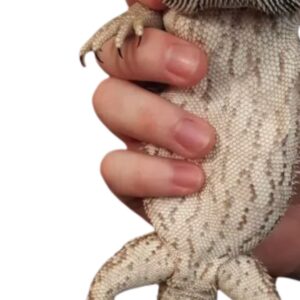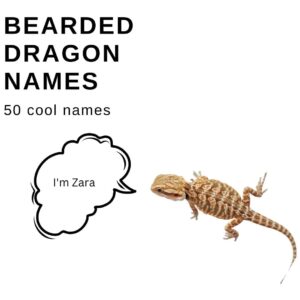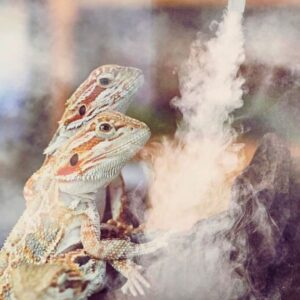Until recently, we didn’t have much research on the intelligence of bearded dragons.
But guess what! They are more intelligent than we thought.
Let’s discuss bearded dragons’ intelligence by exploring their fascinating abilities and summarizing new research discoveries.
Intelligence Of Bearded Dragon: Table of Contents
Bearded dragon’s unique Intelligence features
Newer studies focused on four aspects of bearded dragon behavior:
- Heat respond
- Color vision
- Social learning
- REM and SWS sleep
Heat respond
Being temperature-dependent, bearded dragons can thermoregulate by decreasing or increasing activity, food consumption, and movement speed.
They can adapt to different thermal environments, and this adaptation depends on the quality of the environment.
The study, conducted in controlled settings, evaluated their responses to temperature changes. The results indicated that bearded dragons are precise thermoregulators capable of maintaining specific body temperatures. Their ability to adjust temperature is essential for various aspects of their life, including feeding and avoiding predators.
The study concludes that the strategies the lizards use, with energetically expensive behaviors and energy-saving behaviors, are highly intelligent behaviors.
Overall, bearded dragons exhibit impressive thermoregulatory abilities, showcasing their evolutionary sophistication and emphasizing the need for proper lighting conditions for their comfort.
They can see color
Seeing color helps beardie distinguish their habitat from different objects.
Bearded dragons have photo receptors and neuroreceptors, giving them color vision.
The research paper explores the ability of animals, particularly bearded dragons, to see and distinguish colors. Color vision is uncommon among animals, but it can provide an adaptive advantage by helping them discriminate between objects in their environment.
To possess color vision, an organism must have specific photoreceptors in the retina and the neural capacity to analyze the signals from these receptors.
There are two types of mechanisms involved in color vision:
- achromatic mechanisms for perceiving brightness
- chromatic mechanisms for detecting color
The primary focus of the study is on bearded dragons, specifically their ability to associate color (green) with a food reward and their capacity to discriminate between various colors, regardless of intensity differences. The experiments involved training the dragons to associate specific colors with rewards and testing their ability to choose the correct color in various scenarios.
The results of the experiments indicate that bearded dragons possess color vision and use chromatic neural mechanisms for color discrimination. The study suggests that this ability is not energetically costly and may serve a crucial function in their survival, although the exact reason remains to be discovered.
This research demonstrates that bearded dragons can perceive and differentiate colors. The experiments conducted reveal that chromatic neural mechanisms likely mediate their color vision. This unique trait in bearded dragons adds to our understanding of reptile vision and raises intriguing questions about its evolutionary significance.
Social learning
They can learn social behaviors through imitation and repetitive actions.
The research explores social learning abilities in bearded dragons and how incubation temperatures during their early development might impact their cognitive skills.
Social learning, the ability to acquire knowledge by observing others, has been studied in various animals, including reptiles, challenging the notion that only humans possess this trait.
Bearded dragons are the focus here, and a study conducted at the University of Lincoln involved training them to imitate specific actions demonstrated in a video. The results revealed that bearded dragons, regardless of their incubation temperature, could successfully mimic the actions shown in the video, suggesting that they possess social learning abilities.
However, cold-incubated dragons appeared to learn the task faster and more effectively than their hot-incubated counterparts. These findings raise intriguing questions about how environmental factors during incubation might influence cognitive development in reptiles, shedding light on the complexity of their behavior and learning capabilities.
They can perceive optical illusions
Through a study conducted on how they perceive the Delboeuf illusion, it was found
that bearded dragons perceive illusions in a very human-like way.
The research investigates how different species of reptiles, specifically bearded dragons and red-footed tortoises, perceive optical illusions, shedding light on their visual perception abilities.
Optical illusions are used to understand how animals interpret visual information and adapt to it.
While previous studies have focused on mammals and primates, reptiles have been relatively understudied.
The experiment used a well-known illusion called the Delboeuf illusion, which involves comparing the sizes of two identical circles surrounded by differently-sized circles.
Bearded dragons perceived this illusion similarly to humans, showing evidence of assimilation and contrast effects, which influence their perception of object size.
These findings suggest that reptiles, like bearded dragons, may possess more complex visual perception abilities than previously thought, highlighting the need for further research in this area.
They are capable of REM and short-wave sleep cycle
Studies have examined the sleep patterns of bearded dragons, revealing that they undergo sleep cycles similar to REM (rapid eye movement) and SWS (slow-wave sleep) observed in mammals. Their sleep cycles are less complex than those of humans but involve alternating phases of SWS and REM sleep.
Thermoregulation: Bearded dragons are precise thermoregulators, capable of maintaining a specific body temperature. Many of their behaviors, including feeding and avoiding predators, depend on their ability to regulate their body temperature accurately.
Emotional Intelligence: Do bearded dragons recognize their owners?
Bearded dragons exhibit emotions such as stress, happiness, and affection towards their owners.
They can recognize and respond to their owners’ voices and touch.
Some even display signs of jealousy when they feel neglected.
They are not highly social in nature but can form strong bonds with their owners.
They Show Affection
Bearded dragons may show affection by rubbing their heads against their owner’s hand, licking fingers, or leaning against them.
They can curl up in their owner’s lap and respond to their presence with chirps and head bobs.
Forming a bond with a bearded dragon requires spending time with them and earning their trust.
They don’t need company
Bearded dragons are naturally solitary creatures and do not require the company of other reptiles.
They do not experience loneliness when left alone in their cage.
Despite appearing teary-eyed, they are not sad but may have irritated eyes due to natural causes.
Can bearded dragons see us?
Yes, bearded dragons can see us. Bearded dragons have relatively good vision, and they are capable of seeing their surroundings, including humans. Their eyesight is adapted to detect movement, an important feature for survival in the wild.
Bearded dragons have the unique ability to simultaneously see both in front of them and over their shoulders. Thanks to their lateral eye positioning, this enhanced field of vision allows them to perceive a broader range than humans.
Great care ( adjusted care for senior bearded dragons), optimal nutrition, and a clean environment are key for a healthy bearded dragon.
My Senior Paws is a participant in the Amazon Services LLC Associates Program, an affiliate advertising program designed to provide a means for sites to earn advertising fees by advertising and linking to Amazon.com. We also participate in other affiliate programs which compensate us for referring traffic.




